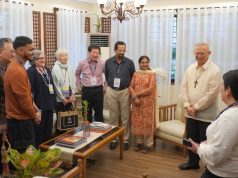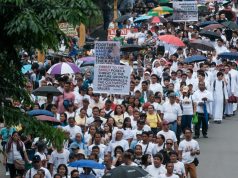
The remarks of Central Visayas police director Brig. Gen. Albert Ferro to supposedly have “tsismosas” or rumormongers as part of their initiative to boost Cebu‘s contract tracing efforts were met with concerns on information credibility and confidentiality.
Ferro reportedly said in jest that he heard a story about a “tsismosa brigade” in what he thought was in Bulacan and added that such people could be tapped to help in contact tracing.
“I heard a story last night about this ‘tsismosa brigade.’ They could be a good source of (information). I think it was in Bulacan. It was said the help of these ‘tsismosas’ is being sought for contact tracing. So maybe, instead of rumormongering, they can do something to help,” he said with a laugh.
Ferro added that a public health crisis involves a community-wide effort, not just the initiatives of the government or the law enforcers.
“This health emergency crisis is not only a job or responsibility of the police, of the military, or the local government. This is a responsibility of every single Sugbuanon, Boholano, Ilonggo, Ilocano, Bisaya, and all the Filipino citizens,” he said.
Central Visayas is the second region that has the most number of active COVID-19 cases as of July 20, based on the Department of Health‘s situational report.
This was not the first time that the move to hire rumormongers as contact tracers was suggested.
Nueva Vizcaya community doctor Anthony Cortez reportedly relied on locals “known to keep an eye on the neighbors” in order to monitor new arrivals in the town of Bambang and quarantine them for possible COVID-19 symptoms.
The locals would relay the information to the village chiefs, who would then report it to Cortez and then send nurses for a follow-up. He was reported to be “careful” in terms of verifying the reports relayed to him.
Concerns
Meanwhile, Ferro’s remarks did not sit well with some Filipinos who shared their fears and concerns about the possibility of solely relying on rumormongers to contact trace people.
“Horrible strategy. Gossipmongers do not inspire confidence and do not command much authority (if at all) in any community. This will only sow divisiveness and unfounded fear while yielding little or no reliable facts,” a Twitter user wrote.
Another online user hoped that the individuals tapped for such an initiative “will be provided the appropriate training including key information regarding privacy and confidentiality,” given that they are prone to gossip.

“Hindi ba magiging issue yung confidentiality ng patient?” wrote another Filipino in response to the news.
“Tsismosas may be good in getting details about other people’s lives, pero di verified yung details na yun. Ganun na ba ang pamamalakad sa bansa natin, not based on verified evidence?” commented another Twitter user.
A Filipino likewise questioned Ferro’s remarks and pointed out that the national government has loaned lots of funds from the global community to fund its response against the COVID-19 pandemic.
“Science is shaking. MYGOD. Php386.6B yung inutang for COVID-19 aid AND THIS IS THE BEST SOLUTION YOU CAN COME UP WITH FOR CONTACT TRACING?” she wrote.
As of July 1, Philstar.com reported that the Philippines has a “total of $7.76 billion worth of foreign loans, grants and securities” to supposedly fund its response for the pandemic.
Investigative skills needed
Baguio City Mayor Benjamin Magalong, the newly-appointed contact tracing czar, earlier said that he will “radically” change the country’s contact tracing structure following his successful initiative in the City of Pines.
He hopes to train the contact tracers’ interviewing skills and teach them to use the government’s “contract tracing e-system” that would collect data.
Magalong has likened the act of contact tracing to “investigating a serial criminal offense” and reiterated that it was not just a matter of getting to identify potential cases.
“Kailangan po natin malaman iyong buong kuwento dahil marami po tayong hinahabol dito – paano na-infect itong tao na ito? Saan galing iyong infection? Ang dami po nating dapat alamin and that is the reason why I keep on saying that contact tracing is very similar po sa pag-iimbestiga po ng isang serial criminal offense,” he said.
“Hindi ho basta-bastang puwede na lang kumuha ng mga ordinary na workers diyan at turuan na lang po diyan because they need to be trained po sa cognitive interviewing skills, pati ho iyong mga basic investigation,” Magalong added.
He likewise said that investigators must be able to help the person recall the incident in as much detail as possible.
Magalong is a former chief of the Philippine National Police Criminal Investigation and Detection Group and Directorate for Investigation and Detective Management.









